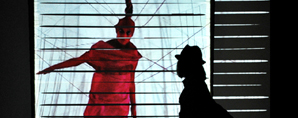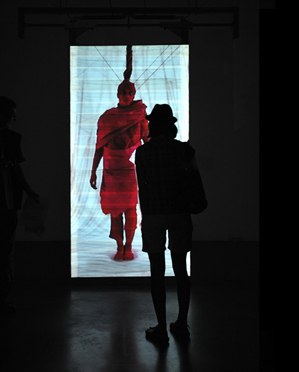
FORMICA 2012 Philomène Longpré
May 21-26, 2012 – International Digital Art Biennale BIAN C2-MTL, E-Merge Exhibit, Art Souterrain – Montreal, CA
June 10 – July 9, 2011 – Collider 3: Transformation – International Digital Art Festival Emily Davis Gallery – Akron, USA
June 17 – August 17, 2010 – Nouveaux Monstres – International Digital Art Festival LIFE Museum – Saint-Nazaire, France
Sept 18 – Nov 8, 2009- LILLE 3000 – Nouveaux Monstres – International Digital Art festival Gare St-Sauveur Museum – Lille, France
January 12 – February 24th, 2007 – FORMICA presented by Group Molior Parisian Laundry Gallery – Montreal, CA
FORMICA is a pneumatic-driven interactive system with a strong metallic frame that houses a delicate video membrane consisting of a series of horizontal elastic slats. A projected virtual character seeks to create connections with visitors as soon as they enter the system’s environment. The visitors transform and trigger links or bonds with the character as infrared sensors pick up their presence and ultrasonic sensors detect their locations. These interactions are visually expressed on the membrane like firing neurons weaving a tapestry of associations. This system by Longpré has received the IT Federation of Quebec OCTAS Award for excellence in digital art and was exhibited at digital art Festivals,namely 2011 Collider 3: Transform in the United States, Nouveaux Monstresin France, the Parisian Laundry, and the DX Center in Canada.
Extract from What Binds Us by Julie Bélisle
« Philomène Longpré strives, among other things, to bring the image back into the concrete context of the world. Her work is constructed around a desire to establish communication between the physical world and the virtual world through ingenious installations that play with new technologies in ways that turn them to her own advantage. Despite the announcement, made by a number of theoreticians, that screens are slated to disappear or at least become invisible, it is by foregrounding screens that the artist gives weight to her images. I refer here not to the kinds of screens that have proliferated in our day-to-day environment — to those on laptop computers, cell phones, electronic agendas, public display boards, and the like. On the contrary, the artist’s kinetic screens overshadow us with their imposing scale and use of unusual materials to play with our perceptual apparatus. Suspended structures hover over us with all their weight, while their movements sometimes create the illusion of evicting the characters that inhabit them. For Longpré’s screens are inhabited. In them, someone lies in wait for us, for information supplied by our very presence and transmitted via motion detectors as they pick up our movements.
The artist works in that zone where the screen and the projected image come into contact, employing technological devices that reconstitute the image by literally becoming of a piece with it. Apart from the surfaces that Longpré invents, the influence of experimental film is pervasive in her visual language. Her references to the film genre are revealed by the same disorientation of our customary practices, a certain disruption of narration and an exploration of psychological states. Each time we have to try to find our point of entry into her images; thus interactivity plays a key role in her installations. Our presence is what initially draws us into them, as we proceed, through our movements, to modify the ways in which the images are projected. Longpré’s moving images are, for the most part, spatial frameworks for fictionalized narratives that evoke different worlds, each belonging to virtual characters. In these pieces, technology serves as a linking device: the artist combines images, colours and sounds, connecting them to infrared sensors, robotic screens and computer programs that, taken together, constitute an imaginary space attached to the physical space. The creation of characters is a constant feature of Longprés’s recent work. Key figures in her video systems, they adopt human forms and strive to establish communication with their environment. Taking her observations of daily interactions as her point of departure, the artist uses personification to embody the ideas she takes from them. (…) »
1 Propos qu’Olivier Asselin rapporte et commente dans « Écrans numériques
», Parachute ,
no 113(Janvier -Février -Mars), p. 6 -11.
Julie Bélisle holds a master’s degree in museology and works at the Galerie de l’UQAM. She is currently pursuing a doctorate in art history, which deals with the processes of collecting and accumulating in contemporary art. In addition to publishing articles on artistic practice in urban environments, she has curated a variety of exhibitions focusing on cultural heritage issues and is involved in research projects on the ways in which material culture is bound up with memory.
FORMICA – selected publications:
Digital Arts Biennial in Montreal PBS, Paul Larson
Digital Art Biennale – BIAN
Art Souterrain
C2-MTL
Ce qui nous attache. Bélisle Julie, Archée
Interaction virtuelle Marilyse Hamelin, La Voix Pop
Philomène Longpré rocks my world: Ooh mama Isa Tousignant, HOUR
Exposition – Interaction virtuelle Michel Hellman, Le Devoir
Pneumatic Video Screen: by Philomene Longpre Julie Bélisle, Rhizome
Dress to Kill Magazine, “Art Interactif” (page 1). Paul Larson
Dress to Kill Magazine, “Art Interactif” (page 2). Paul Larson
Photo Credits:
Photos 1-2-3 : LIFE MUSEUM – Lille France



